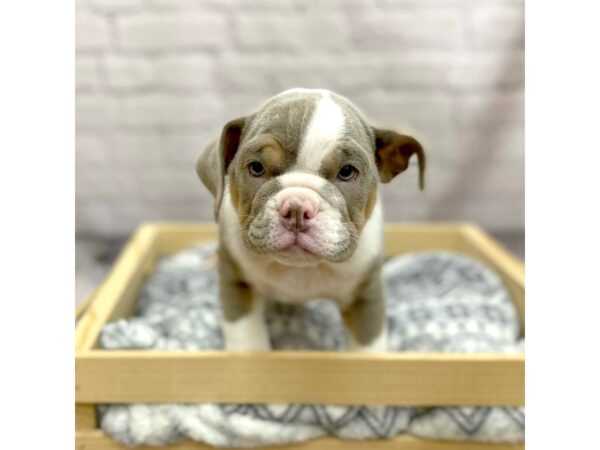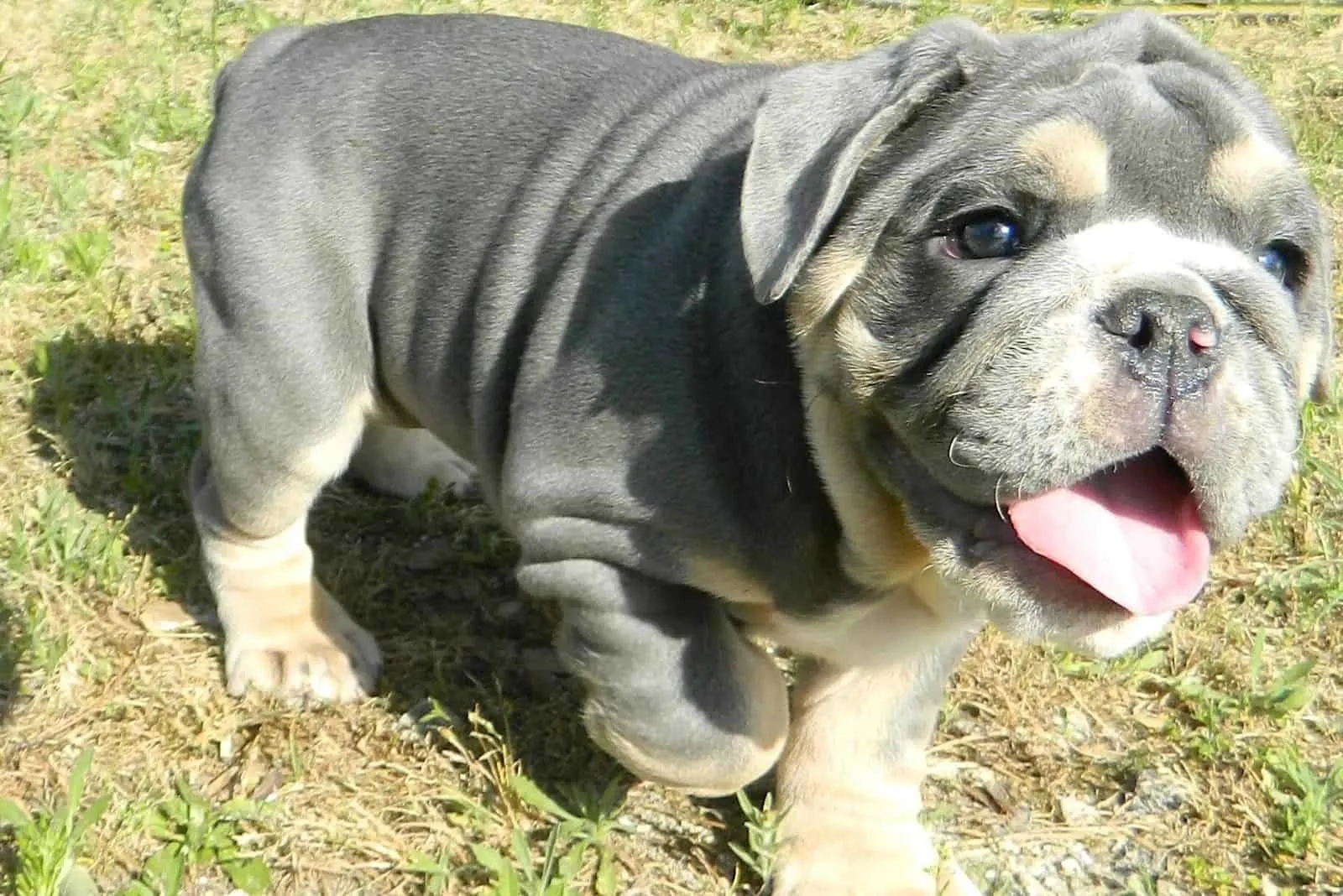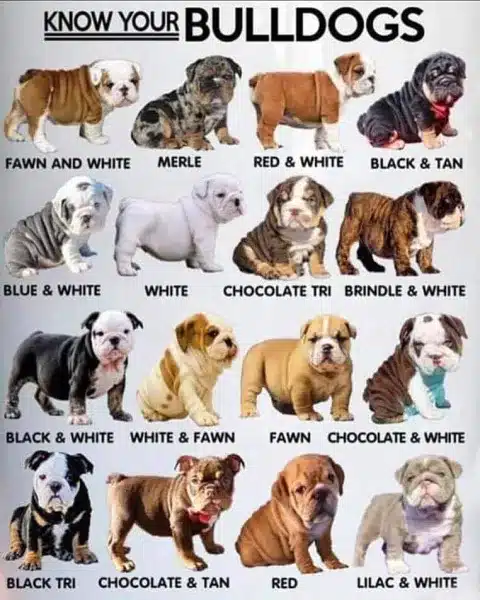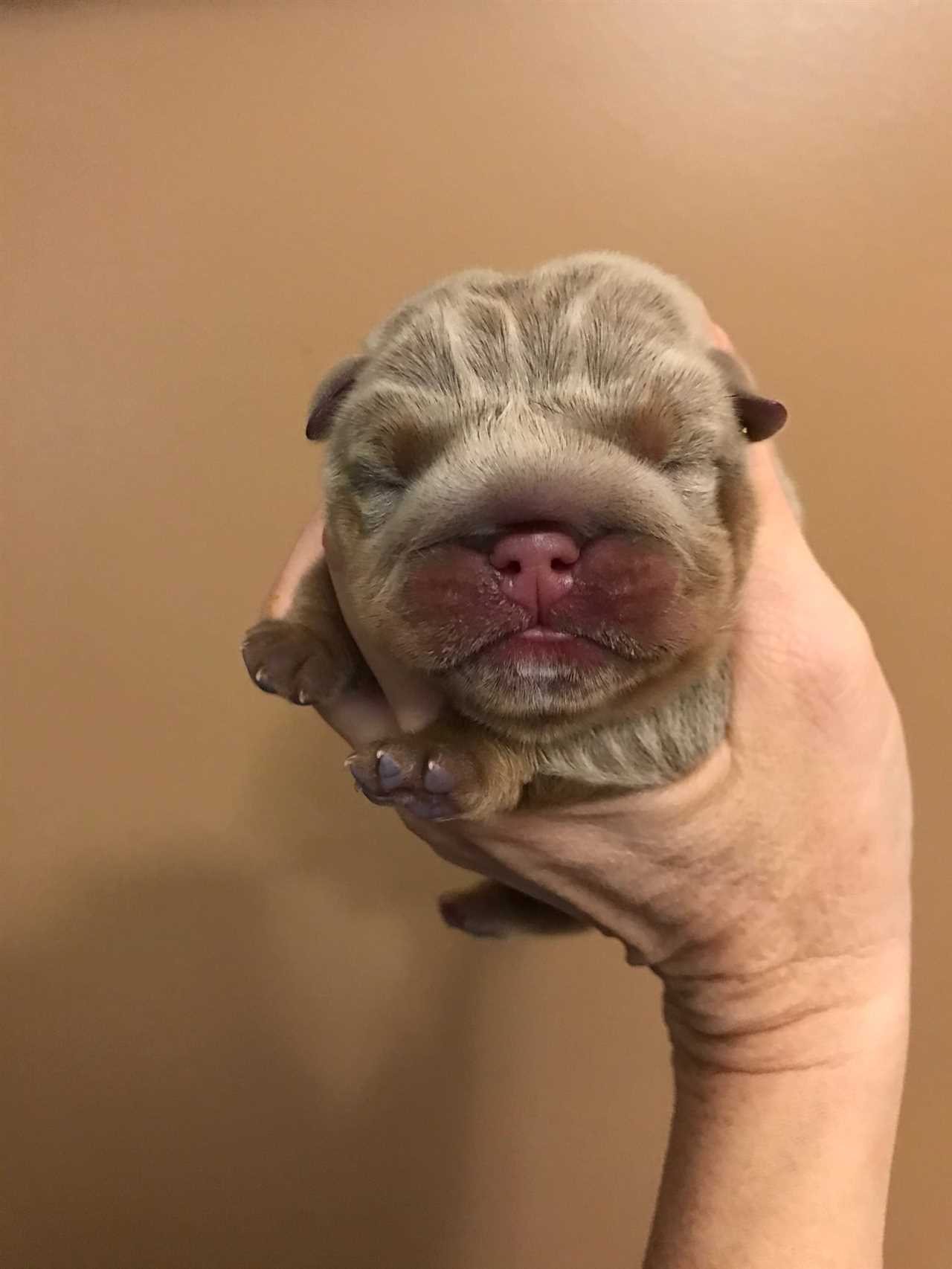
The Lilac Tri English Bulldog is a unique and mesmerizing breed that has gained popularity in recent years. With its striking coat color and distinctive markings, this bulldog stands out from the crowd. In this comprehensive overview, we will delve into the characteristics, history, and care requirements of the Lilac Tri English Bulldog.
The Lilac Tri English Bulldog is known for its rare and beautiful lilac coat color. This unique coloring is a result of a combination of genes that produce a dilute shade of brownish-gray, often with a hint of purple. The tri-color pattern adds another layer of allure, with patches of tan or white on the body and face. This combination of colors creates a stunning and eye-catching appearance that is sure to turn heads.
Originating from the English Bulldog breed, the Lilac Tri English Bulldog has a rich history. Bulldogs were originally bred for bull-baiting, a popular sport in medieval England. Over time, the breed was refined and developed into the lovable and affectionate companion we know today. The Lilac Tri variation is a relatively new addition to the breed, resulting from careful breeding and genetic selection to achieve the desired coat color and markings.
When it comes to care, the Lilac Tri English Bulldog requires regular grooming to maintain its coat’s luster and health. Brushing their short hair once or twice a week will help remove loose fur and keep their coat looking its best. Additionally, regular bathing and cleaning of their facial wrinkles are essential to prevent skin infections. Like all bulldogs, they are prone to certain health issues, so regular veterinary check-ups and a balanced diet are crucial to their overall well-being.
Appearance

The Lilac Tri English Bulldog is a unique and striking breed known for its distinctive appearance. They have a compact and muscular build, with a wide chest and a thick, powerful neck. Their head is large and square-shaped, with a wrinkled forehead and a broad muzzle. The eyes are round and set low, giving them an intense and determined expression.
One of the most notable features of the Lilac Tri English Bulldog is their coat color. They have a beautiful lilac base coat, which is a dilute form of blue. This color is often accompanied by patches of tan or white, creating a tri-color pattern. The coat is short and smooth, giving the dog a sleek and glossy appearance.
In addition to their unique coat color, these Bulldogs also have other distinctive physical characteristics. They have a wide, undershot jaw, which gives them their signature “smushed” face. Their ears are small and set high on the head, often folded or rose-shaped. The tail is short and carried low, adding to their overall balanced and sturdy appearance.
Overall, the Lilac Tri English Bulldog is a visually striking breed with a combination of unique physical features. Their muscular build, wrinkled face, and beautiful coat color make them stand out among other dog breeds.
Color Genetics

The Lilac Tri English Bulldog is known for its unique and eye-catching coloration. Understanding the color genetics behind this breed can help breeders and owners better appreciate and care for these beautiful dogs.
Coat Colors

The Lilac Tri English Bulldog has a coat that is predominantly lilac in color, which is a diluted form of chocolate. This dilution is caused by the presence of the “d” gene, which affects the production of pigment in the coat. The lilac color is further enhanced by the presence of the “b” gene, which affects the production of brown pigment. The combination of these genes results in the distinct and desirable lilac coat color.
In addition to the lilac color, these Bulldogs also have patches of white and tan on their coat, creating the “tri” pattern. The white color is caused by the presence of the “s” gene, which inhibits the production of pigment. The tan color is caused by the presence of the “at” gene, which affects the distribution of pigment in the coat. The combination of these genes with the lilac color creates the striking tri-color pattern that is characteristic of the Lilac Tri English Bulldog.
Inheritance

The color genetics of the Lilac Tri English Bulldog follow a complex inheritance pattern. Both the “d” gene and the “b” gene are recessive, meaning that the dog must inherit two copies of the gene (one from each parent) in order to display the lilac color. Similarly, the “s” gene and the “at” gene are also recessive, requiring two copies for the white and tan patches to be present.
Because of this complex inheritance pattern, breeding Lilac Tri English Bulldogs can be challenging. Breeders must carefully select mating pairs to ensure that the desired coloration is passed on to the offspring. Genetic testing is often used to determine the presence of these genes and guide breeding decisions.
Popularity and Controversy

The Lilac Tri English Bulldog’s unique coloration has gained popularity in recent years, leading to an increase in demand for these dogs. However, it is important to note that the breeding of these dogs for their specific coloration has sparked controversy within the dog breeding community.
Some argue that focusing on color genetics can lead to health issues and genetic abnormalities in the breed. Others believe that responsible breeding practices, including genetic testing and health screening, can mitigate these risks and ensure the overall health and well-being of the dogs.
Ultimately, it is crucial for breeders and owners to prioritize the health and welfare of the Lilac Tri English Bulldog above its coloration. Responsible breeding practices and proper care are essential to maintaining the breed’s overall health and preserving its unique color genetics.
Temperament

The Lilac Tri English Bulldog is known for its friendly and affectionate temperament. They are loyal and devoted to their owners, making them excellent family pets. Despite their muscular build and strong appearance, they are generally gentle and good-natured. They are known to be patient and tolerant, especially with children, making them a great choice for families with young kids.
These dogs are also known for their playful and fun-loving nature. They have a great sense of humor and enjoy entertaining their owners with their silly antics. They love to be the center of attention and will often go to great lengths to make their owners laugh.
While they are generally friendly, it’s important to note that the Lilac Tri English Bulldog can be protective of their family. They have a strong instinct to protect their loved ones and will not hesitate to defend them if they feel threatened. This makes them excellent guard dogs and they will often bark to alert their owners of any potential danger.
In terms of socialization, it’s important to expose these dogs to different people, animals, and environments from a young age. This will help them develop into well-rounded and confident adults. Early socialization will also help prevent any potential behavioral issues, such as aggression or fearfulness.
Overall, the Lilac Tri English Bulldog is a loving and loyal companion with a playful and protective nature. With proper training and socialization, they can make wonderful family pets and are sure to bring joy and laughter to any household.
Health and Care

The health and care of a Lilac Tri English Bulldog are of utmost importance to ensure a happy and fulfilling life for this unique breed. Here are some key factors to consider:
Diet
A balanced and nutritious diet is crucial for the overall health and well-being of a Lilac Tri English Bulldog. It is recommended to feed them high-quality dog food that is specifically formulated for Bulldogs. This breed is prone to obesity, so it is important to monitor their food intake and avoid overfeeding. Additionally, Bulldogs can have sensitive stomachs, so it is important to avoid feeding them foods that may cause digestive issues, such as grains, soy, and dairy products.
Exercise

Regular exercise is important for the physical and mental well-being of a Lilac Tri English Bulldog. However, it is important to note that Bulldogs are not a highly active breed and can easily become overheated or exhausted. Therefore, it is recommended to provide them with short, low-intensity exercise sessions, such as leisurely walks or playtime in a fenced yard. It is important to avoid exercising them in extreme temperatures and to always provide them with plenty of water.
Grooming

Lilac Tri English Bulldogs have a short and smooth coat that requires minimal grooming. Regular brushing with a soft bristle brush can help keep their coat clean and free from loose hair. It is also important to regularly clean their facial folds and wrinkles to prevent any skin infections. Additionally, regular nail trimming, ear cleaning, and teeth brushing are essential parts of their grooming routine.
Health Issues

Like all dog breeds, Lilac Tri English Bulldogs are prone to certain health issues. Some common health problems that can affect this breed include brachycephalic syndrome, hip dysplasia, allergies, and skin infections. It is important to be aware of these potential health issues and to regularly monitor the dog’s health. Regular veterinary check-ups and vaccinations are also essential to ensure the overall health and well-being of the dog.
Training and Exercise
Training and exercise are crucial for the well-being and overall development of a Lilac Tri English Bulldog. These dogs are intelligent and eager to please, making them relatively easy to train. However, it is essential to use positive reinforcement techniques and be patient and consistent in your training approach.
Start training your Lilac Tri English Bulldog from a young age to establish good behavior patterns and prevent any potential behavioral issues. Basic obedience commands such as sit, stay, come, and down should be taught early on. Use rewards such as treats, praise, and playtime to motivate your dog and reinforce good behavior.
Regular exercise is also important for a Lilac Tri English Bulldog. While they are not overly active dogs, they still require daily physical activity to maintain a healthy weight and prevent boredom. A daily walk or play session in a secure, fenced area is usually sufficient for meeting their exercise needs.
Keep in mind that Lilac Tri English Bulldogs are brachycephalic breeds, meaning they have a short muzzle and can have difficulty breathing in hot or humid weather. Avoid exercising them during the hottest parts of the day and provide plenty of water and shade during outdoor activities.
In addition to physical exercise, mental stimulation is also essential for a Lilac Tri English Bulldog. Engage their minds with puzzle toys, interactive games, and training sessions that challenge their problem-solving skills. This will help prevent boredom and destructive behaviors that can arise from a lack of mental stimulation.
Lastly, socialization is crucial for a Lilac Tri English Bulldog. Expose them to various environments, people, and other animals from a young age to ensure they grow up to be well-rounded and friendly dogs. Enroll them in puppy socialization classes and continue to expose them to new experiences throughout their lives.
Remember to always be patient, positive, and consistent in your training and exercise routines. With the right approach, your Lilac Tri English Bulldog will become a well-behaved and happy companion.
History and Origins

The Lilac Tri English Bulldog is a unique and rare breed that has gained popularity in recent years. This breed is a result of carefully planned breeding programs that aimed to produce a bulldog with a distinct lilac coat color and tri markings.
The origins of the Lilac Tri English Bulldog can be traced back to the traditional English Bulldog, which was bred for bull-baiting in England in the 18th century. These Bulldogs were known for their strength, tenacity, and courage.
Over time, the English Bulldog’s purpose shifted from bull-baiting to companion and show dog. Breeders started focusing on improving the breed’s appearance and temperament, resulting in the Bulldog we know today.
The Lilac Tri English Bulldog, with its unique lilac coat color and tri markings, is a relatively recent development in the breed. The lilac color is a dilute form of chocolate, and the tri markings refer to the presence of three distinct colors on the coat (usually lilac, tan, and white).
Breeders have carefully selected Bulldogs with the desired lilac and tri genes to create the Lilac Tri English Bulldog. This has involved extensive knowledge of color genetics and careful breeding practices to achieve the desired results.
Today, the Lilac Tri English Bulldog is highly sought after for its unique and striking appearance. It is important to note that this breed is still relatively rare, and finding a reputable breeder can be challenging. It is essential to do thorough research and ensure that the breeder follows ethical breeding practices.
Finding a Lilac Tri English Bulldog

If you are interested in owning a Lilac Tri English Bulldog, it is important to find a reputable breeder who specializes in this specific color and genetic combination. Due to the rarity and popularity of the Lilac Tri color, it may be difficult to find a puppy available for sale.
One of the best ways to find a Lilac Tri English Bulldog is to attend dog shows or events where breeders showcase their dogs. This will give you the opportunity to meet breeders in person, see their dogs, and discuss the possibility of purchasing a puppy.
Another option is to search online for breeders who specialize in Lilac Tri English Bulldogs. Make sure to do thorough research on any breeder you are considering, checking their reputation, customer reviews, and health testing practices. It is important to ensure that the breeder follows ethical breeding practices and prioritizes the health and well-being of their dogs.
When contacting breeders, be prepared to ask questions about the health and genetic testing of their breeding dogs, as well as any guarantees or warranties they offer for their puppies. A responsible breeder will be happy to answer your questions and provide documentation of health testing.
Be aware that Lilac Tri English Bulldogs may come with a higher price tag due to their rarity. It is important to be prepared for the financial commitment of owning a Bulldog, including potential veterinary expenses.
If you are unable to find a Lilac Tri English Bulldog through a breeder, you may consider reaching out to Bulldog rescue organizations. While it is less likely to find a specific color and genetic combination through rescue, there may be Bulldogs in need of a loving home.
Remember, owning a Lilac Tri English Bulldog is a long-term commitment. Make sure you are fully prepared for the responsibility and care that comes with owning this unique and beautiful breed.
| Pros | Cons |
|---|---|
| Unique and rare color | Higher price tag |
| Opportunity to meet breeders in person | Difficulty in finding available puppies |
| Reputable breeders prioritize health testing | Potential veterinary expenses |
| Rescue organizations may have Bulldogs in need of a home | Less likely to find specific color and genetic combination through rescue |

Tyler Newsom, a canine enthusiast, is passionate about bulldogs and their coat care. With years of experience and dedication, he shares his expertise to help bulldog owners maintain their beloved pets’ fur health and vitality through practical tips and advice.
